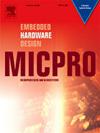Extended design and linearity analysis of a 6-bit low-area hybrid ADC design for local system-on-chip measurements
IF 2.6
4区 计算机科学
Q3 COMPUTER SCIENCE, HARDWARE & ARCHITECTURE
引用次数: 0
Abstract
The low observability of analog signals inside modern low-area system-on-chips (SoCs) results in an increasing need for Design for Testability (DfT) solutions. These solutions demand an optimal circuit design in terms of area, power consumption, and precision, with a focus on minimizing area overhead per SoC circuit blocks. To address this demand, we present a 6-bit, low-area Hybrid Analog-to-Digital Converter (ADC) that measures analog voltage inside SoCs locally. The proposed Hybrid ADC consists of two sub-ADCs: A 3-bit SAR ADC for coarse measurements and a 3-bit Flash ADC for fine measurements.
The advantage of the proposed ADC design is its low additional area cost to each IP of SoCs due to its specific design. It can also have a shared fine Flash part, which has the dominant area in the design. This ADC design converts the analog signals, which are difficult to read from SoC pins, to the digital domain, where they are easy to route and observe.
The suggested ADC is designed and analyzed using the 130 nm technology of Infineon, and it has a total area of 0.007 mm2. The areas of the fine Flash and coarse SAR parts are 0.0015 mm2 and 0.0042 mm2 respectively. The Signal-to-Noise Distortion Ratio (SNDR) of the design is 37 dB, and the Figure of Merit (FoM) is 2.15 pJ/conv.
用于本地片上系统测量的6位低面积混合ADC设计的扩展设计和线性分析
现代低面积片上系统(soc)中模拟信号的低可观测性导致对可测试性设计(DfT)解决方案的需求日益增加。这些解决方案需要在面积、功耗和精度方面进行优化电路设计,重点是尽量减少每个SoC电路块的面积开销。为了满足这一需求,我们提出了一种6位,低面积混合模数转换器(ADC),可在本地测量soc内部的模拟电压。提出的混合ADC由两个子ADC组成:用于粗测量的3位SAR ADC和用于精细测量的3位Flash ADC。所提出的ADC设计的优势在于,由于其特殊的设计,每个soc IP的额外面积成本很低。它也可以有一个共享的精美的Flash部分,在设计中占主导地位。该ADC设计将难以从SoC引脚读取的模拟信号转换为易于路由和观察的数字域。所建议的ADC采用英飞凌的130纳米技术进行设计和分析,其总面积为0.007 mm2。精细部分的面积为0.0015 mm2,粗糙部分的面积为0.0042 mm2。该设计的信噪比(SNDR)为37 dB,性能因数(FoM)为2.15 pJ/conv。
本文章由计算机程序翻译,如有差异,请以英文原文为准。
求助全文
约1分钟内获得全文
求助全文
来源期刊

Microprocessors and Microsystems
工程技术-工程:电子与电气
CiteScore
6.90
自引率
3.80%
发文量
204
审稿时长
172 days
期刊介绍:
Microprocessors and Microsystems: Embedded Hardware Design (MICPRO) is a journal covering all design and architectural aspects related to embedded systems hardware. This includes different embedded system hardware platforms ranging from custom hardware via reconfigurable systems and application specific processors to general purpose embedded processors. Special emphasis is put on novel complex embedded architectures, such as systems on chip (SoC), systems on a programmable/reconfigurable chip (SoPC) and multi-processor systems on a chip (MPSoC), as well as, their memory and communication methods and structures, such as network-on-chip (NoC).
Design automation of such systems including methodologies, techniques, flows and tools for their design, as well as, novel designs of hardware components fall within the scope of this journal. Novel cyber-physical applications that use embedded systems are also central in this journal. While software is not in the main focus of this journal, methods of hardware/software co-design, as well as, application restructuring and mapping to embedded hardware platforms, that consider interplay between software and hardware components with emphasis on hardware, are also in the journal scope.
 求助内容:
求助内容: 应助结果提醒方式:
应助结果提醒方式:


